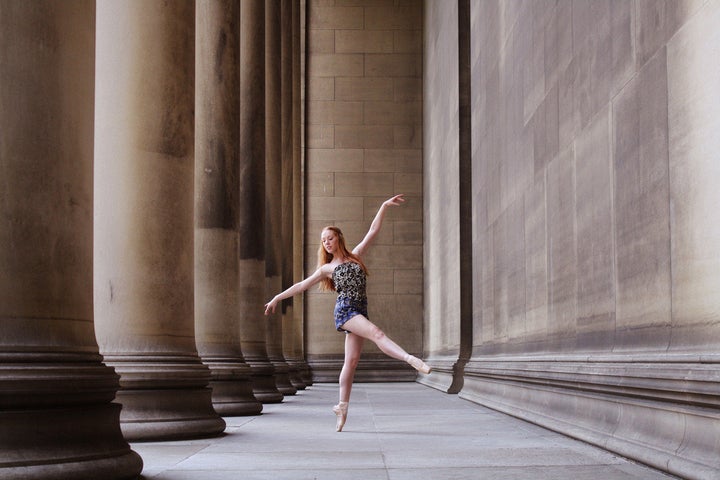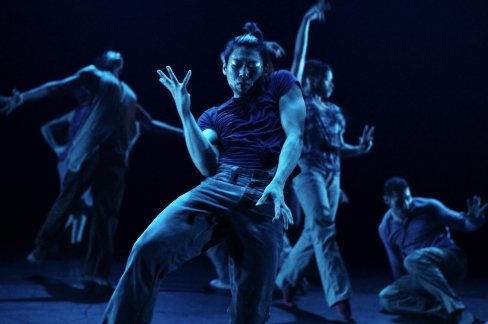
Cedar Lake Contemporary Ballet has a repertoire full of "sock ballets," typified by the thin socks the dancers often wear to help them glide over the floor, but also by a general slipperiness. Fluid and changeable, they flatter dancers: Each beautiful position bleeds into the next one, so that mistakes and flaws don't have time to crystallize. Not that it's hard to make Cedar Lake's dancers -- ballet's cool kids -- look good. Elastic, catlike, intensely physical, they're distinct individuals who harmonize well, different notes in a single rich chord.
Sock ballets are de rigueur in Europe, and Cedar Lake's Paris-born artistic director, Benoit-Swan Pouffer, has decidedly European tastes; he commissions and collects pieces by choreographers unfamiliar here but renowned on the continent. Many of these dances are forgettable, sliding out of the mind as easily as they slide into it. Angelin Preljocaj's Annonciation, the second of three ballets on the company's Joyce Theater program this week, is worse: regrettable.
We don't need the grandiose program note explaining the work's connection to the biblical story of the annunciation ("Isn't what we call nowadays conceptual art the portent of a new art, the Annonciation of an art yet to be born?"). If the title doesn't give it away, Preljocaj's vulgar choreography does. As the electronic gasps and shrieks of Stephanie Roy's Crystal Music brutalize Vivaldi's Magnificat, Acacia Schachte's angel Gabriel terrorizes Harumi Terayama's poor Mary -- burying her face in Mary's belly, thrusting her thumb into her mouth, manipulating her with her foot. After the two share a lingering kiss, Gabriel finally exits; Mary draws her hands across her eyes and extends her arms behind her in an ecstatic gesture of understanding and acceptance. It is difficult for us to be as forgiving.
But the evening's two other works stick, in the brain and the craw. Choreographers Hofesh Shechter and Crystal Pite are indebted to their very different mentors: Shechter is a disciple of Batsheva Dance Company director Ohad Naharin, Pite of The Forsythe Company's William Forsythe. But it's the similarities between Shechter's Violet Kid and Pite's Grace Engine that are most striking. Both pieces rely on visceral movement, choreography that literally comes from the gut; rarely does either allow the dancers to stand fully upright. Both use vividly theatrical lighting, often from overhead, as if filtered through a sewer grate. And both are driven by hugely amplified, percussive rhythms.
Even if you don't enjoy these oversaturated worlds, you can't help but vibrate at their frequency. They appeal to a primeval part of us. They go right for the brain stem.

Cedar Lake Contemporary Ballet in Violet Kid. Photo by Julieta Cervantes.
Violet Kid is reminiscent of Shechter's earlier Uprising -- it has the same feeling of a pot about to come to a boil, and some of the same dance motifs. But it feels younger. Uprising was about men on the verge of rebellion; Violet Kid channels pubescent angst. In their ratty flannels, the dancers look like they smell like teen spirit.
The piece opens with all of them standing sullenly at the front of the stage as a voice-over intones: "Do I talk too much? Maybe if I didn't talk too much I'd have more friends. I need to simplify things." There is a blackout, and when the lights come up again, one boy is on his knees; another holds a hand to the back of his head, his fingers forming a gun. It's an impassioned but empty menace -- perfectly adolescent. These kids want us to take them seriously.
Shechter composed Violet Kid's score himself, layering distorted percussion over long, low, shivery string chords (played live on a platform above the stage). The dancers rock out to it, headbang, shake uncontrollably, run in circles. They pair up for a demented tango, connected at the tops of their heads, one dancer's hand encircling the other's neck. This is a community united and crippled by directionless rage. Unfortunately the work feels directionless, too -- diffuse, impotent, random. That might be on purpose. But it makes it hard to digest.
In a way Grace Engine is the grown-up version of Violet Kid's teenage wasteland: The dancers wear suits, and a string of fluorescent lights overhead makes it look like they're in some corporate dungeon. But at least Shechter's kids have each other. In Grace Engine, nobody can be trusted. Jon Bond, the first dancer to enter the stage -- walking in time to the sound of footsteps -- turns to look over his shoulder. We see that he's right to be suspicious: Another dancer is standing upstage, watching him. Suddenly, to the sound of an approaching train, the whole cast races past, leaving Bond behind to convulse in a fit of paranoid agony.
It only gets worse. Pite has crafted a waking nightmare, a chain of horror-movie images that zooms by continuously, relentlessly. The dancers open their mouths in silent screams (a grating Forsythe signature), appear to be running but get nowhere, suffer epileptic fits. Owen Belton's fractured score, a mishmash of street noise and electronica, adds to the sense of meaningless chaos. By 10 minutes into Grace Engine, our nerves are as frayed as the dancers' are.
Pite's last work for Cedar Lake, Ten Duets on a Theme of Rescue, was just as dark. But it was also poetic and intimate. Grace Engine feels alien, impersonal, hopeless. We just want this apocalyptic world to reach its end already.
--------
A former dancer and choreographer, Margaret Fuhrer is an associate editor at "Dance Spirit" and "Pointe" magazines.